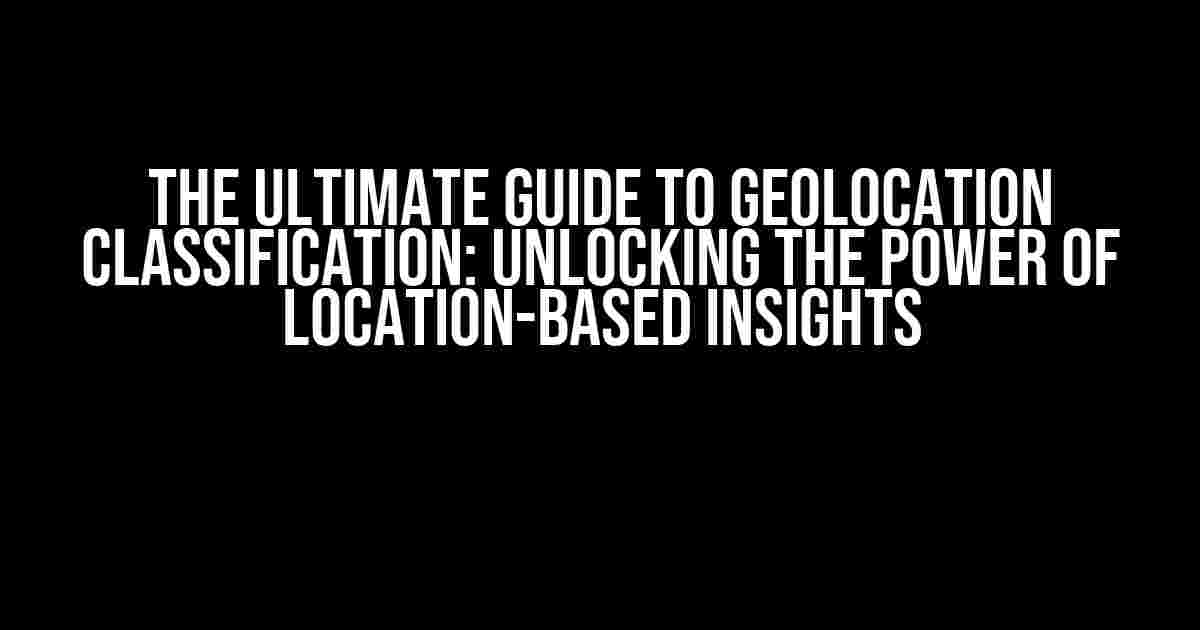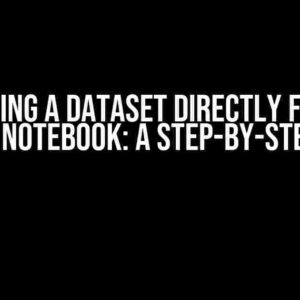Imagine being able to pinpoint a customer’s location and tailor your marketing strategy to their exact geographical context. Welcome to the world of GeoLocation classification, where the art of pinpointing a user’s location meets the science of data analysis. In this comprehensive guide, we’ll delve into the world of GeoLocation classification, exploring its benefits, techniques, and best practices to help you unlock the full potential of location-based insights.
What is GeoLocation Classification?
GeoLocation classification is the process of identifying and categorizing a user’s location based on their geographic coordinates, such as latitude and longitude. This information can be obtained through various means, including IP addresses, GPS signals, and Wi-Fi triangulation. By classifying users based on their location, businesses can create targeted marketing campaigns, optimize their online presence, and improve customer experiences.
Benefits of GeoLocation Classification
- Targeted Marketing: With GeoLocation classification, you can create targeted marketing campaigns that resonate with your audience based on their location, climate, and cultural context.
- Improved Customer Experience: By understanding a user’s location, you can provide personalized content, offers, and services that cater to their unique needs and preferences.
- Competitive Advantage: GeoLocation classification provides a competitive edge by allowing you to identify untapped markets, optimize your online presence, and stay ahead of the competition.
- Enhanced Analytics: Location-based insights can help you better understand your customers’ behavior, preferences, and pain points, enabling data-driven decision-making.
Techniques for GeoLocation Classification
There are several techniques used in GeoLocation classification, each with its own strengths and weaknesses. Let’s dive into the most commonly used methods:
IP Address-Based Classification
This method involves mapping an IP address to a specific geographic location using IP geolocation databases or APIs. While IP address-based classification is widely used, it can be inaccurate due to factors like VPNs, proxies, and IP address spoofing.
GPS and Wi-Fi-Based Classification
This method uses GPS signals and Wi-Fi triangulation to determine a user’s location. GPS-based classification is more accurate than IP address-based classification, but it requires user consent and can be affected by environmental factors like signal strength and interference.
This method uses cellular network data to determine a user’s location. Cellular network-based classification is more accurate than IP address-based classification and can provide real-time location data, but it requires collaboration with mobile network operators.
Best Practices for GeoLocation Classification
To ensure the accuracy and effectiveness of your GeoLocation classification strategy, follow these best practices:
- Use Multiple Data Sources: Combine IP address, GPS, and cellular network data to increase the accuracy of your GeoLocation classification.
- Implement User Consent: Ensure that users provide explicit consent before collecting their location data to comply with data privacy regulations.
- Use Advanced Analytics: Leverage machine learning algorithms and data visualization tools to extract meaningful insights from your location-based data.
- Regularly Update Your Database: Update your GeoLocation database regularly to reflect changes in IP address allocations, network infrastructure, and user behavior.
GeoLocation Classification in Real-World Scenarios
GeoLocation classification has a wide range of applications across various industries. Let’s explore some real-world scenarios:
E-Commerce and Retail
Imagine an e-commerce platform that offers location-based discounts, personalized product recommendations, and optimized shipping routes based on a customer’s location.
Healthcare and Emergency Services
A healthcare organization can use GeoLocation classification to identify high-risk areas for disease outbreaks, optimize ambulance routes, and provide targeted health campaigns.
Financial Services and Banking
A bank can use GeoLocation classification to detect fraudulent transactions, offer location-based services, and tailor loan offers to specific regions.
GeoLocation Classification Tools and Resources
Here are some popular tools and resources for GeoLocation classification:
| Tool/Resource | Description |
|---|---|
| MaxMind | A popular IP geolocation database provider offering accurate location data. |
| Google Maps API | A suite of APIs for geocoding, mapping, and location-based services. |
| OpenCage Geocoder | An open-source geocoder for forward and reverse geocoding. |
| LocationIQ | A location-based data and analytics platform for businesses. |
Conclusion
GeoLocation classification is a powerful tool for businesses seeking to unlock the potential of location-based insights. By understanding the techniques, benefits, and best practices of GeoLocation classification, you can create targeted marketing campaigns, improve customer experiences, and gain a competitive edge in your industry. Remember to stay up-to-date with the latest developments in GeoLocation classification and adapt your strategy to comply with data privacy regulations and user consent.
What’s Next?
Start exploring the world of GeoLocation classification today! Implement location-based marketing strategies, experiment with different techniques, and stay tuned for the latest advancements in this exciting field.
// Sample GeoLocation classification code in Python
import requests
def get_location(ip_address):
response = requests.get(f"https://api.ipgeolocation.io/ipgeo?apiKey=YOUR_API_KEY&ip={ip_address}")
data = response.json()
return data["country_name"], data["city"], data["latitude"], data["longitude"]
ip_address = "192.0.2.1"
country, city, latitude, longitude = get_location(ip_address)
print(f"Location: {country}, {city} ({latitude}, {longitude})")
Frequently Asked Questions
- Q: What is the most accurate method of GeoLocation classification? A: GPS-based classification is generally considered the most accurate method, but it requires user consent and can be affected by environmental factors.
- Q: Is GeoLocation classification compliant with data privacy regulations? A: GeoLocation classification can be compliant with data privacy regulations if implemented with user consent and proper data protection measures.
- Q: Can I use GeoLocation classification for real-time location tracking? A: Yes, GeoLocation classification can be used for real-time location tracking, but it requires advanced analytics and data processing capabilities.
Now that you’ve mastered the art of GeoLocation classification, it’s time to unlock the power of location-based insights and take your business to the next level!
Frequently Asked Question
Get ready to unleash the power of GeoLocation classification!
What is GeoLocation classification, and why is it important?
GeoLocation classification is the process of automatically identifying the geographic location of a user, device, or object based on their IP address, Wi-Fi, GPS, or other location-based data. It’s crucial in today’s digital landscape because it enables businesses to target their audience more effectively, improve user experience, and comply with various regulations.
How does GeoLocation classification work, technically speaking?
GeoLocation classification typically involves a combination of techniques, including IP geolocation databases, GPS tracking, cellular tower triangulation, and Wi-Fi-based positioning. These methods allow systems to pinpoint a device’s location with varying degrees of accuracy, from country and city to zip code and even specific coordinates.
What are some common use cases for GeoLocation classification?
GeoLocation classification has numerous applications, including content localization, targeted advertising, geofencing, fraud detection, and compliance with regional regulations. It can also enhance user experience in areas like language support, currency conversion, and weather forecasting.
How accurate is GeoLocation classification, and what are the limitations?
The accuracy of GeoLocation classification can vary greatly depending on the method used and the quality of the data. While IP geolocation can be accurate up to 90%, GPS tracking can provide accuracy within a few meters. However, limitations include issues with VPNs, proxy servers, and outdated IP address databases.
Is GeoLocation classification compliant with data privacy regulations like GDPR and CCPA?
GeoLocation classification can be compliant with data privacy regulations, but it requires careful consideration of user consent, data anonymization, and transparency. Businesses must ensure they obtain explicit user consent, implement adequate data protection measures, and provide clear opt-out options to avoid potential legal issues.



